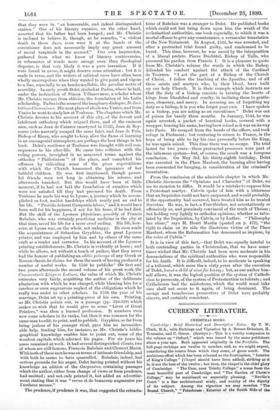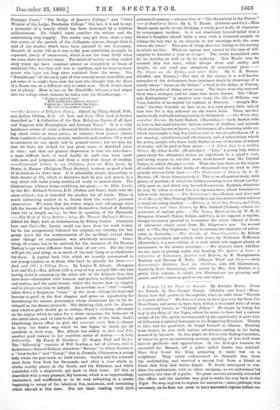CURRENT LITERATURE.
CHRISTMAS BOORS.
Cambridge: Brief Historical and Descriptive Notes. By T. W. Clark, M.A., with Etchings and Vignettes by A. Brunet-Debaines, H. Toussaint, and C. Grenx. (Seeleys.)—This is a worthy companion to the volume on "Oxford," which was issued by the same publishers about a year ago. Both appeared originally in the Portfolio. The fall-page etchings are twelve in number, and, as we might expect, considering the source from which they come, of great merit. The ambitious effort which has been selected as the frontispiece, "Interior of King's College" (Chapel should have been added), striking as it is, is not the best of the twelve ; but then, the chapel is the chief glory of Cambridge. "The Cam, near Trinity College," a scene from the most beautiful part of Cambridge, and "The Garden of Christ's College," may be mentioned as especially pleasing. "Neville's Court" is a fine architectural study, and worthy of the dignity of its subject. Among the vignettes we may mention "The Round Church," "Peterhouse: Exterior of the South Side of the
Principal Court," "The Bridge of Queen's College," and "Oriel Window of the Lodge, Pembroke College," this last, it is sad to say, a memorial of a beauty which has been destroyed by a ruthless utilitarianism. Mr. Clark's notes combine the serious and the entertaining very happily. The reader may get from them a very fair notion of the growth of the Collegiate system, though little is said of the studies which have been pursued in the University.
Records of social life as it was in the past contribute, as might be expected, plenty of amusement, which is not the least lively when we come down to recent times. The habits of society as they existed sixty years ago have vanished almost as completely as those of medimval life; but they still live in tradition, and we seem to know actors who have not long since vanished from the scene. The " donnishness" of the early part of this century seems incredible, and yet some of us might have seen the men who thought that the Head of a House was of a different clay to other men. Good stories there are in plenty. Here is one, on Dr. Hinchliffe, who put a bad singer into the college choir, because he had a vote for Peterborough :—
" A singer, and not sing !
How justify your patron's bounty?
Forgive me ; you mistake the thing ; My voice is in another county!"
—The Library of Religious Poetry. Edited by Philip Schaff, D.D., and Arthur Gilman, M.A. (S. Low and Co.)—This book is further described as "A Collection of the Best Religious Poems of all Ages and Tongues, with Biographical and Literary Notes." It is a very handsome octavo of about a thousand double-column pages, contain- ing about twice as many poems, or extracts from poems, chosen from hundreds of authors, ancient, modiwval, and modern. Of a work so extensive, we can speak only in general terms ; but we may say that we have not looked for any- great name or standard poem in vain ; and that our general impression is that the selection— a most difficult task, it need hardly be said—has been made with taste and judgment, and from a very wide range of reading. —Illustrated Letters to my Children, from the Holy Land, by Henry A. Harper (Religious Tract Society), is about as good a book of its kind as we have seen. It is admirably simple, descending to little details of life, which it describes both by pen and pencil, in a way which will make young readers all ready to realise them. The illustrations, without being ambitious, are good.—In Bible Lands, by the Rev. Richard Newton, D.D. (Nelson and Sons), deals with the same subject ; but is intended for readers for all kinds. There is much interesting matter in it, drawn from the writer's personal observation. We think that the writer might with advantage have left the lessons of his facts to unfold themselves, instead of drawing them out at length, as, e.g., he does in speaking of the Pyramids. —The Book of King Arthur ; being Sir Thomas Mallory's History. Edited for Boys, with an Introduction, by Sidney Lanier. (Sampson Low and Co.)—Mr. Lanier could not have done his work better, for he has scrupulously followed his original, not altering the lan- guage (save for the modernisation of the spelling), except when some change or explanation was absolutely necessary. Some- thing, of course, has to be omitted, for the manners of Sir Thomas Mallory's age were different from those of our own. But the boys will get the real thing, or as much of the real thing as is wholesome for them. A capital book this, which we heartily recommend to our young readers, or to those who have to provide for them.— .Tack and Jill : a Village Story. By Louisa M. Allcott. (Sampson Low and Co.)—Mrs. Allcott tells a story of boy and girl life—the two having more in common on the other side of the Atlantic than they have here—diversified with humour and pathos, incidents laughable and serious, and the quiet lessons which she knows how to suggest and is always too wise to intrude. An accident on a "sled "—rashly taken down a dangerous " coast " in the snow—brings the hero and heroine to grief in the first chapter, and gives an opportunity for introducing the various personages whose characters are to be de- veloped as the drama proceeds. The debating club, with its discus- sion whether girls should go to college, Frank's exciting adventure on the engine which he takes for a short excursion, the humours of the cattle show, and, to turn to the graver side of the book, Jack's blundering, brave effort to give the rnauvais sujet, Bob, a chance to keep the better way which he has begun to tread, are all excellent in their way. Mrs. Allcott has added, in Jack and Jill, another good volume to her excellent series of stories.—A Jolly Fellowship. By Frank R. Stockton. (C. Kegan Paul arid Co.)— The " fellowship " consists of Will Gordon, a lad of sixteen, who is spokesman ; Samuel Colbert, otherwise "Rectns," to whom Gordon is a "bear-leader ;" and "Corny," that is, Cornelia, Chipperton, a young lady whom the pair meet on their travels. Gordon and his comrade start from New York for Savannah, and after a tear which in- cludes sundry places in the South, and the Bahamas, and which concludes with a shipwreck, get back to their home. All this is described with a very pleasant, dry humour, which is so unpretending, nnstrained, and unaffected, as to be very refreshing to a reader beginning to weary of the laborious fun, sentiment, and moralising which abound at this time. Nor are there wanting -vivid little pictures of scenery,—witness that of "The Steamboat in the Forest." —A Dweller in Tents. By L. T. Meade. (Isbiater and Co.)—Miss Meade again spoils, to our thinking, a really good study of character by extravagant incident. Is it not absolutely beyond belief that a farmer's daughter should bribe a man with a thousand pounds to kidnap the boy who is an obstacle to her marriage with the man whom she loves ? This sort of thing does not belong to the society in which we live. What an uproar was caused by the ease of kid- napping in America a year or so ago ! The crime astonished men by its novelty, as well as by its audacity. Miss Meade may be assured that her tales, which always show real ability and insight, do not need any attraction of sensational plots. — The House on the Bridge, and other Tales. By C. E. Bowen. (Griffith and Farran.)—The first of the stories is a well-known narrative of the deliverance from imminent death by drowning of a family whose "house on the bridge" a flood in the Adige, at Verona, was on the point of being swept away. The brave man who rescued them was a stranger, and his name was never known. The " Brua- eels Knifegrinder " is another true story, the life of Wilhelm von Voss, founder of an asylum for orphans in Brussels. " Scrag's Mis- sion," whether founded on fact or no, is a very pretty little tale of how love for a dog softened an old man's heart. There are tivo stories in all, well told and appropriately illustrated.—The White Rat, and other Stories. By Lady Barker. (Macinillan.)—Lady Barker tolls us hero in her usual pleasant fashion stories of children and animals whom she has known or knows, as, for instance, of a charming white rat which was taught to beg dog fashion and to run steeple-chases, of a pet monkey, mischievous and affectionate, and of other things which the young people, who know Lady Barker as one of the best of tellers of stories, will be glad to hear about.—A Silver Key to a Golden Palace. By Alton Leslie. (Routledge.)—" Lily," a young lady with a great thirst for adventure, makes an expedition in a gipsy's cart, and seeing reason to cut this short, finds herself near the Crystal Palace, to which she pays a visit. What she sees there in the region of realities and the wider realm of dreamland may be read in this prettily written little book.—The Fisherman of Ithava, by C. E. Browne. (W. Swan Sonnenschein.)—This is an allegorical story, with plenty of incident, of which the hidden meaning is not thrust too for- cibly upon us, and which may be called a success. Djalmali, whatever he may be taken to stand for, is a vigorous hero, whose fortunes we follow with interest.—The Fisherman's Boy (Nelson and Son) and Aunt Mary, by Mrs. Purring (Routledge), are two stories which enforce a moral on young readers.—Ilistory of Good Dog Fanny, and Tuft, the Canary, and other Stories, by Mrs. Gaskell (Nelson), relates ex- periences of various pets.—The Young Derringtons, by W. H. G. Kingston (Cassell, Pater, Galpin, and Co.), is, we suppose, a reprint, though we cannot pretend to remember the whole library of books of adventure which came from Mr. Kingston's pen. Its second title is "The Boy Explorers," and it contains the narrative of adven- tures in Australia.—The Secrets of Stage-Conjuring, by Robert Houdin, translated and edited, with notes, by Professor Hoffmann (Routledge), is a new edition of a work which will suggest plenty of amusement in the winter evenings.—We scarcely know whether we are right in putting under this heading The Quiver of Love : a Collection of Valentines, Ancient and Modern, by R. Montgomerie Ranking and Thomas R. Tully. (Marcus Ward and Co.)—Kate Greenaway's Birthday Book for Children, with 302 illustrations, drawn by Kate Greenaway, with verses by Mrs. Salo Barker, is a pretty little volume, in which the illustrations are pleasing and quaint, and the verses as good as one can expect.



































 Previous page
Previous page